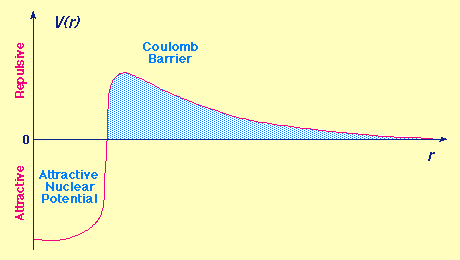In the fusion of light elements to form heavier ones the nuclei (which carry
positive electrical charge) must be forced close enough together to cause them to
fuse into a single heavier nucleus.
The Coulomb Barrier
The electrical repulsion produces a barrier to this process called a
Coulomb barrier, as illustrated in the following figure, which shows the
potential energy of such a system as a function of the separation r
between the nuclei.
 |
|
Coulomb barrier for charged-particle reactions
|
This figure indicates that the force between nuclei
is repulsive until a very
small distance separates them, and then it rapidly becomes very attractive.
Therefore, in order to surmount the Coulomb barrier and bring the
nuclei close together where the strong attractive forces can be felt, the kinetic
energy of the particles must be as high as the top of the Coulomb barrier.
Quantum Mechanical Tunneling
In reality, the situation is helped by effects associated with quantum mechanics.
Because of what is termed the
Heisenberg Uncertainty Principle,
even if the particles do not have enough energy to pass over the barrier
there is a very small probabability that the particles pass
through the barrier. This is called barrier penetration or
tunneling, and is the means by
which many such reactions take place in stars. Nevertheless, because this
process happens with very small probability, the Coulomb barrier represents a
strong hindrance to nuclear reactions in stars.
Overcoming the Coulomb Barrier
The key to initiating a fusion reaction is for the nuclei that are to fuse to
collide at very high velocities, thus driving them close enough together for the
strong (but very short-ranged) nuclear forces to overcome the electrical repulsion
between them. In stars, the probabability of this happening is governed by the
temperature and the density at the center of the star.

